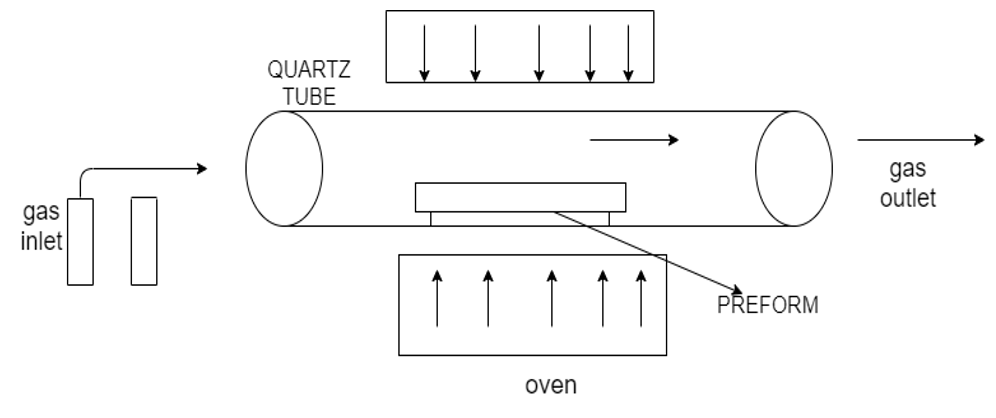This set of Composite Materials Multiple Choice Questions & Answers (MCQs) focuses on “Carbon Matrix Composites – Set 2”.
1. What is the method of manufacturing C-C composites other than the Liquid infiltration process?
a) Chemical vapour deposition
b) Compocasting
c) Squeeze casting
d) Powder metallurgy
View Answer
Explanation: Chemical vapour deposition (CVD)process can be also used for the manufacture of C-C composites. In this process, the carbon fiber preform is infiltrated with a hydrocarbon gas at high pressure and temperature. The carbon matrix is produced by the chemical breakdown of hydrocarbon gas. The CVD process is generally used with thin sections of fiber preforms.
2. Which is not a liquid used in the liquid infiltration method?
a) Isotropic pitch
b) Mesophase pitch
c) Thermoset resin
d) Liquid carbon dioxide
View Answer
Explanation: There are two types of liquids used in the liquid infiltration process. The first is the pitch which is made from petroleum or coal tar. Either isotropic or mesophase pitch is used in the liquid infiltration process. The second is the thermoset resin such as an epoxy or phenolic resin.
3. What is the minimum required temperature for the pitch liquid infiltration process?
a) 200°C
b) 600°C
c) 1000°C
d) 1600°C
View Answer
Explanation: In the pitch infiltration process, the dry fiber preform is infiltrated by a pitch at a temperature of 1000°C or higher and at a pressure level ranging from 207 MPa. This temperature is essential for the proper carbonization process to occur simultaneously with the infiltration process.
4. What is the carbon yield percentage with isotropic pitch liquid infiltration?
a) 10-20%
b) 30-40%
c) 50-60%
d) 70-80%
View Answer
Explanation: The carbon yield with an isotropic pitch is about 50-60 wt%. While with a mesophase pitch the carbon yield is greater than 80%. The carbon yield will become higher with an increase in the pressure.
5. What can be done to reduce porosity in the composite during manufacturing?
a) Repeating carbonization
b) Increasing temperature
c) Increasing pressure
d) Concentrating the infiltrating liquid
View Answer
Explanation: The presence of porosity defect on the composite surface will lead to a decrease in its density. Moreover, it also leads to the formation of microcracks. Since the porosity greatly influences the property of the composite, it is needed to be minimized. It can be effectively reduced by repeated carbonization cycles. This process is also called densification.
6. In the Chemical vapour deposition process, the preform is heated in the presence of hydrocarbon gas.
a) True
b) False
View Answer
Explanation: The preform is heated in the presence of a hydrocarbon gas such as benzene, methane or propane under certain pressure. The thermal decomposition of this gas will lead to the formation of a pyrolytic carbon layer and it will get deposited on the hot preform surface.
7. What is the temperature maintained in the furnace in the Chemical vapour deposition process?
a) 500°C
b) 1100°C
c) 1500°C
d) 1900°C
View Answer
Explanation: The temperature of the furnace during an isothermal chemical vapour deposition process is maintained constant at 1100°C. This temperature is maintained in order for the proper occurrence of the carbonization process which is necessary for the minimization of porosity defects.
8. The infiltration will be better by creating a thermal gradient across the thickness of the preform in the CVD process.
a) True
b) False
View Answer
Explanation: In the thermal gradient technique, the temperature of one surface will be maintained different from the other surface. As a result, the carbon infiltration will be from the hotter surface to the colder. This is done to overcome the deposition of carbon on the surface which obviously closes the pores on it and makes it very difficult for the carbon to fill the internal pores. Like thermal gradient, a pressure gradient can be also created as a solution to this problem.
9. The microstructure of the carbon matrix in C–C composites may vary depending on the starting material.
a) True
b) False
View Answer
Explanation: The microstructure of the carbon matrix in C-C composite may vary from highly oriented, randomly oriented crystallites, small, and graphitized crystallites depending upon the starting material and the process condition. The porosity defects and microcracks may also be present in the carbon matrix due to improper carbonization.
10. Identify the process shown in the diagram.

a) Liquid infiltration process
b) Chemical vapour deposition
c) Chemical vapour infiltration
d) Polymer pyrolysis
View Answer
Explanation: The chemical vapour deposition process is shown in this diagram. It is a process used for the manufacturing of carbon matrix composite. In this process, the carbon fiber preform is infiltrated with a hydrocarbon gas at high pressure and temperature. The carbon matrix is produced by the chemical breakdown of hydrocarbon gas. The oven is maintained at a temperature of 1100°C.
Sanfoundry Global Education & Learning Series – Composite Materials.
To practice all areas of Composite Materials, here is complete set of 1000+ Multiple Choice Questions and Answers.
If you find a mistake in question / option / answer, kindly take a screenshot and email to [email protected]
